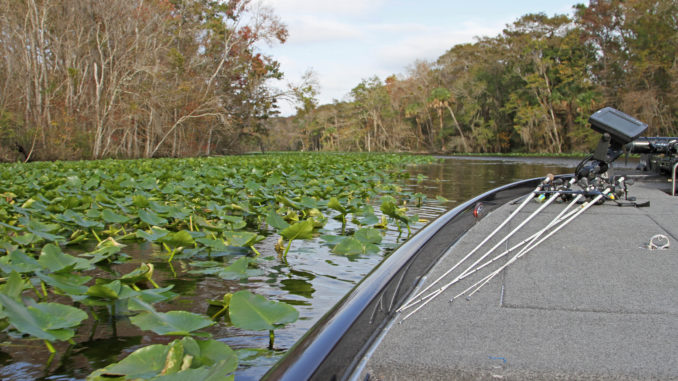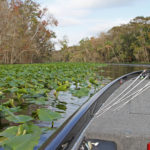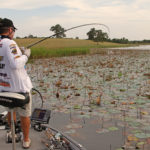
Learn how to dissect a set of lily pads and catch more bass.
Summertime thoughts commonly turn to beach getaways, but the sun-driven heat leaves us adding an umbrella to that picture. And while we’re on the comfort kick, how ’bout some food? Sounds like a nice vacation, but shelter from the swelter and something for the belly also defines the attraction of lily pads for largemouth bass.
Ranging in coverage from small scattered patches to sprawling fields that blanket shorelines, pads address the key areas of need for summer bass: shade and forage. Loaded with bluegill, crawfish, frogs, various minnows and dragonflies perched vulnerably on blossoms; this neighborhood’s never short on chow.
Add to this a strategic roof made of all those mini-umbrellas, and fish have a shadow-casting coverage with plenty of space through which to attack surface prey.
When sizing up a lake’s offering of lily pads, first consider general positioning. Any spot with a foot or more of water could, conceivably, hold a few bass, but areas of significant opportunity are typically well defined.
For example, lily pads sprouting in a shallow, stagnant slough probably hold less potential than a lush field of pads growing in a well-oxygenated area with good exposure to wind-driven current. Expansive habitat like pads needs a steady flow of new water and nutrients to maintain the vibrant ecosystem that keeps the fridge stocked.
Time management always serves an angler’s objectives, but it’s especially pertinent when targeting pads. Specifically, a broad field can keep you busy for a long time, and if the fish are biting, then all is well. However, you may have to cover a lot of water to find the fish, as they tend to group in certain key areas.
The other school of thought points to the smaller, isolated stands of lily pads tucked away all by their lonesome. These unassuming spots are often overlooked and therefore, less pressured. The overall numbers of fish may be less, but you’ll spend less time looking.
Combining these two thoughts, we come to the strategy of targeting smaller stands of pads until you determine a replicable pattern that will likely stand consistent throughout the lake. Maybe it’s a depth zone, a certain contour feature or a particular area of the pads — inside or outside edge.
Often, bass like a laydown or a stump that punctuates the pads. Whatever the case, starting on smaller, more manageable pad fields can help you determine a pattern you can use to more quickly break down a larger area.
No matter what size pad field you tackle, you’ll do yourself a favor by pausing every few minutes and just listening. Active pad fields are rarely silent. Do you hear the pops and smacks of bluegill slurping bugs off the surface? Do you hear frogs leaping into the water? How about the rustle of pads rubbing together as fish move among the stems below?
Consider also how windy days affect this game. Essentially, a good blow will oxygenate the shallow, inside edges and thereby stimulate baitfish activity. Meanwhile, strong winds can make it harder to maintain proper boat positioning on the deeper outside edges.
In most scenarios, you’ll do well to start at the pads’ perimeter and work progressively inward. Fish will roam the edges in the low light of early morning, evening and overcast conditions, while sunny times push them deeper into the shadow realm. Even if you hit the pads during the brighter times, you don’t want to burn any potential by charging right into the center. Pace your approach and give the area a thorough search.
Productive tactics include:
Hop to it. For locating fish in pads, it’s hard to beat a hollow-body frog. Some like popping frogs for the spitting disturbance they make in the open lanes, but for hopping across dense pads, the narrow nose of a standard walking frog tends to minimize hang-ups.
Top talk. Targets are limited, but working topwater walkers, poppers and wake baits through open lanes in the pads and around the edges is a good bet for those low-light periods.
The weighting game. Flip or pitch Texas-rigged lizards, worms and beaver-style baits into pockets and holes within the pads. A ¼- to ½-ounce weight escorts them nicely through loosely clustered pads, but for blankets of green, you may need to punch through the pads and secondary vegetation with a ¾- to 1-ounce weight.
The old softie. For optimal versatility as a primary bait or a follow-up to topwater misses, keep a Texas-rigged soft plastic stick bait handy. Skip it across the pads, drop it into holes or swim it through open lanes.
Perimeter patrol. Check the outer edges with a swimbait, swim jig or spinnerbait, or add a light bullet weight to the nose of that soft plastic swimbait. Another option is to wacky rig a finesse worm or stickbait and let it wiggle enticingly down the edge of the pads.
Whatever bait you throw, tackle up and give yourself the optimal blend of access and fish-fighting leverage. That means long rods in the 7-foot-3 to 8-foot range — something with plenty of backbone — and beefy line. Braid is your best bet for slicing through the vegetation, but stout fluorocarbon may be the way to go for wacky rigging and weightless worms.
Remember, a hooked fish knows just how to use those thick pad stems to its advantage, so lean back hard, get the fish’s head up and yield not an inch until your fish clears the cover.
And then go get another one. There’s probably plenty more hiding in those pads.





Be the first to comment